An easy tip for weeding without chemicals
This is a very simple, effective way of weeding without chemicals (and almost without effort). It comes from the Abbey Physic Garden in Faversham.
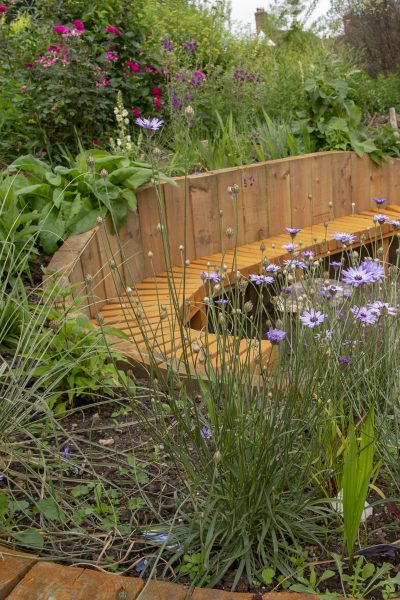
The Abbey Physic Garden in Faversham trials different methods of organic and chemical free gardening, including chemical-free weeding.
The Abbey Physic garden is a wildlife-friendly, organic community garden with a specific aim to improve mental and physical health.
Start with some cardboard
I visited them last March. And I saw a number of shrubs and small trees with cardboard covering the earth around them.
You then add homemade compost on top of the cardboard, so you can’t see the cardboard.
The cardboard helps suppress perennial weeds. It slowly decomposes with the mulch.
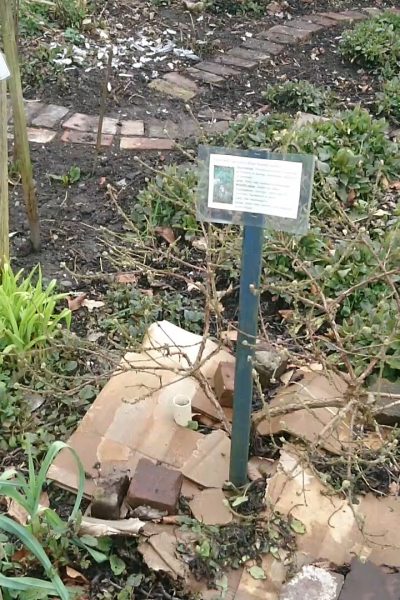
No need for weeding – the cardboard around the base of this plant will disappear from sight when it’s covered in mulch. But it’ll act as a weed preventer until the cardboard decomposes.
I tried this out around a fairly newly planted silver birch. It’s in a bed which gets very crowded, and I wanted to give it space, not just from weeds but also from encroaching plants.
But there are snowdrops planted around the base of the tree. I didn’t want to miss out on those.
Time it so you still get bulbs…
In April, when the snowdrop foliage was gone, I covered the earth around the tree with cardboard.
I added a layer of mulch on top. I didn’t have to weed around the tree at all until around late August, when some annuals weeds settled on top.
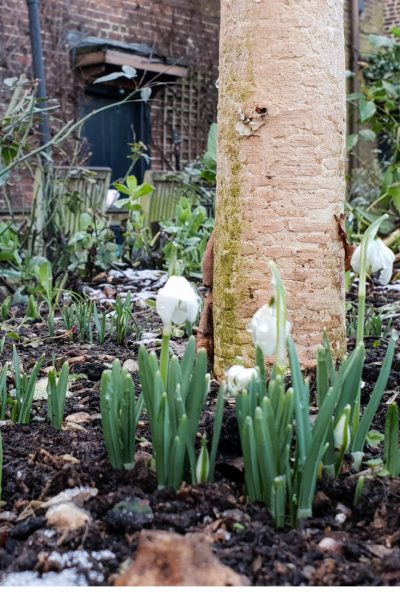
The snowdrops are up, so the cardboard I laid down in April must have decomposed.
And now, in February, all the snowdrops have come through. So the cardboard has now mulched down, improving the soil.
I’ll add another layer of cardboard and mulch when the snowdrop foliage dies down.
And I’m going to protect several newly planted rose bushes in the same way.
Better than a weed-suppressing membrane?
I prefer cardboard to a manufactured weed-suppressing material because cardboard decomposes. I have one bed that is infested with bindweed, but which has glorious bulbs in the spring.
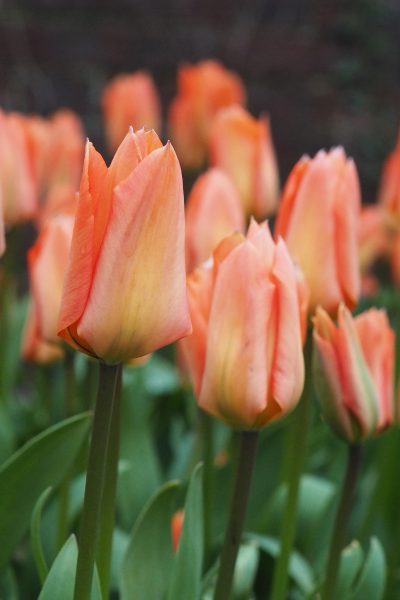
These Emperor tulips emerge in April, and the bindweed doesn’t come up till May, so I’m hoping I can use a cardboard mulch to deal with the bindweed without losing the tulips. I’ll report back!
A cardboard layer may help suppress the bindweed over the summer and it will have disappeared by the time the bulbs come up this time next year.
I’ll report back on how successful it is.
Could you put a layer of cardboard over the whole bed?
In theory, I could get rid of my chronic weed problem by putting a layer of cardboard and mulch over the whole border.
However, there are a number of perennial plants and bulbs that come up at different times. I wouldn’t cover a border in cardboard while there are alliums, dahlias or other plants waiting to emerge.
I also love self-seeded plants, and those won’t pop up through cardboard.
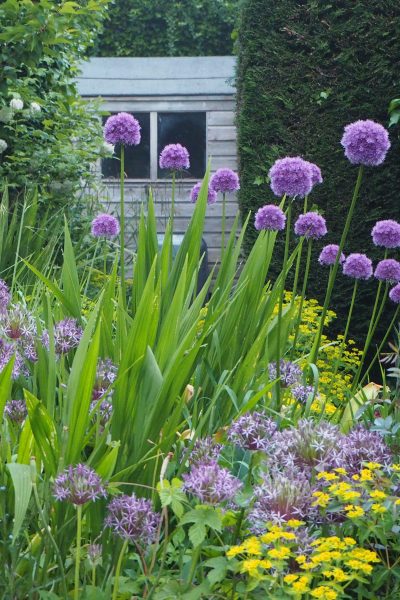
Almost everything in this picture is self-seeded – the alliums, euphorbia and spikes of wild gladioli, so I would lose alot if I covered the whole bed in a weed-suppressing cardboard.
But the self-seeders do crowd out newly planted plants. So I have found it useful to add the cardboard and mulch around anything young that I think needs a bit of space to get established.
Not all weeds….
It took me a while to grasp the difference between weeding out annual weeds and perennial weeds.
Annual weeds come from seeds. These are blown around on the wind, dropped by birds or dug up when you dig the soil.
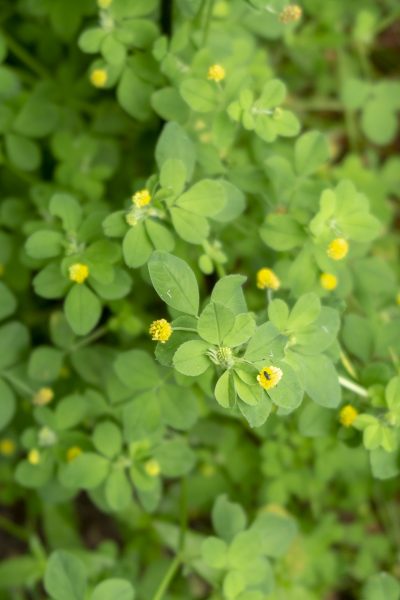
Black medic (aka yellow trefoil) is a relatively new arrival in the garden. It’s an annual weed (and an absolute thug). It has probably been blown in on the wind or arrived with another plant.
A weed suppressing layer, such as cardboard, will only prevent you exposing annual weed seeds through digging. It won’t stop them blowing in and landing on the mulch.
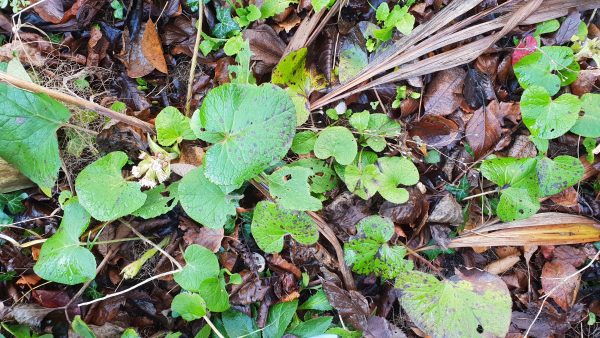
Butterburr or winter heliotrope romps through in my garden. It’s a perennial and its roots get everywhere, but it didn’t come through the cardboard.
Perennial weeds, such as bindweed and ground elder, spread by their roots. These are often dormant in the winter.
A light-preventing layer, such as cardboard and mulch, will discourage them. Although they will certainly try to come up elsewhere. But starving perennial weeds of light can be more effective than digging them up, as so many can re-sprout from the tiniest bit of root.
This week’s video
This week’s video is the February garden tour. And there’s a look at the practical areas of the garden too.
You can visit the Abbey Physic Garden from Wednesdays to Sundays – it’s a wonderful place to spend time and there are lots of good tips for environmentally-friendly gardening.
It’s also open for Faversham Open Gardens & Garden Market Day on 30th June, 2019.
And for more middle-sized garden tips and garden tours, do join us every Sunday morning – follow us by email.
Pin for reference
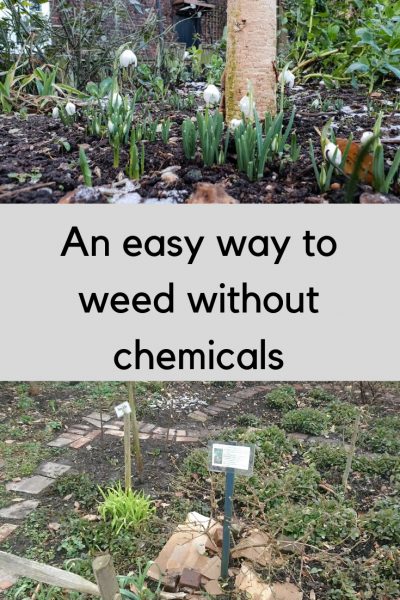
























Cardboard and mulch is also the technique espoused by Charles Dowding of No Dig fame. I used it to clear a lawnof poor grass. It is now in a position to be planted through the mulch. Hooray!
Yes, you’re right – I hadn’t seen him do small patches of cardboard, but am a great fan of his YouTube channel which is so good at explaining how to do No Dig veg. And No Dig is brilliant.
Cardboard great idea. I’ll be doing that from now on.
Great, glad it’s helpful.
Cardboard is terrific for converting lawn area to planting beds, too. I dig only the new border line, then use the Faversham technique to eliminate the grass. It takes a few months, of course, but it is certainly easy!
That’s an excellent method of making new beds.